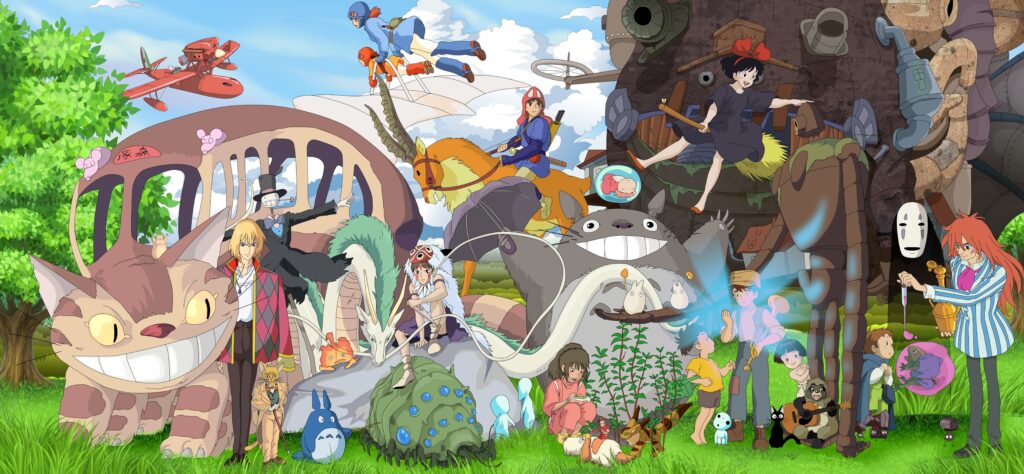Introduction: That First Magical Moment
Do you remember the first time a Studio Ghibli film truly swept you away? For me, it was a rainy Saturday afternoon when I was twelve. I popped in a worn-out VHS of My Neighbor Totoro (yes, I’m dating myself here), and within minutes, I was completely transported. The way the wind rustled through the grass, the warmth of Satsuki and Mei’s sisterly bond, Totoro’s goofy grin – it all felt more real than anything I’d ever watched before.
That’s the Ghibli magic. These aren’t just movies – they’re experiences that nestle into your heart and never leave. Decades later, I still get that same flutter of excitement when the Ghibli logo appears on screen. Let’s explore why these handcrafted masterpieces continue to captivate us in our fast-paced, digital world.
The Secret Ingredients of Ghibli’s Magic
1. The Beauty of Imperfection
Unlike the slick, computer-perfected animation we’re used to today, Ghibli films breathe. You can almost see the pencil strokes in each frame. Remember that scene in Spirited Away where Chihiro’s tears make ripples in her soup? The way the liquid moves isn’t scientifically perfect – it’s emotionally perfect. That’s the difference.
2. Characters Who Feel Like Old Friends
Ghibli gives us heroes who:
- Whine about moving (Totoro)
- Accidentally turn their little sisters into mice (Howl’s Moving Castle)
- Aren’t traditionally “special” at all (Kiki’s Delivery Service)
They’re messy, relatable, and utterly human – even when they’re flying on broomsticks or talking to fish spirits.
3. Food That Makes Your Stomach Growl
Let’s be real – no one animates food like Ghibli. That moment in Ponyo when she devours ramen with pure childish joy? Or the simple perfection of Calcifer’s bacon and eggs? These scenes stick with you longer than most restaurant meals.
Your Personal Ghibli Journey
If You’re New to Ghibli:
Start with My Neighbor Totoro → Kiki’s Delivery Service → Spirited Away
(Like a perfect three-course meal of Ghibli goodness)
If You Think You’ve Seen Them All:
Seek out Only Yesterday (1991) – A stunningly mature look at adulthood
The Wind Rises (2013) – Miyazaki’s most personal, bittersweet work
When You Need a Good Ugly-Cry:
- Make tea
- Grab tissues
- Press play on Grave of the Fireflies
(You’ve been warned)
Why Modern Animation Still Can’t Catch Up
While other studios chase hyper-realistic CGI, Ghibli’s legacy lives on in:
- The cozy magic of The Boy and the Heron’s dreamlike sequences
- How Your Name captures that same bittersweet longing
- The way Pixar’s Turning Red channels Ghibli’s understanding of girlhood
Yet no one quite replicates that feeling when the lights dim and Joe Hisaishi’s score begins…
FAQ: Your Ghibli Questions Answered
Q: Why do I feel so emotional watching these “kids’ movies”?
A: Because Miyazaki never believed in talking down to children. His films tackle loneliness, environmental destruction, and the pain of growing up – just wrapped in beautiful fantasy.
Q: What’s the most underrated Ghibli film?
A: Whisper of the Heart (1995) – A love letter to creativity that every aspiring artist needs to see.
Q: Is it true Miyazaki comes out of retirement for one last film every few years?
A: [laughs] It’s become a running joke in the anime community. The man’s like a cinematic Michael Jordan – he just can’t stay away.
Final Thoughts: Keeping the Magic Alive
In a world that often feels increasingly cynical, Studio Ghibli films remain these precious pockets of warmth. They remind us to:
- Find wonder in ordinary moments
- Appreciate the natural world around us
- Believe in our own resilience
So tonight, why not revisit an old favorite? Or better yet – introduce someone new to the magic. Watch their eyes light up when Totoro first appears, or when Kiki takes flight over that gorgeous seaside city.



